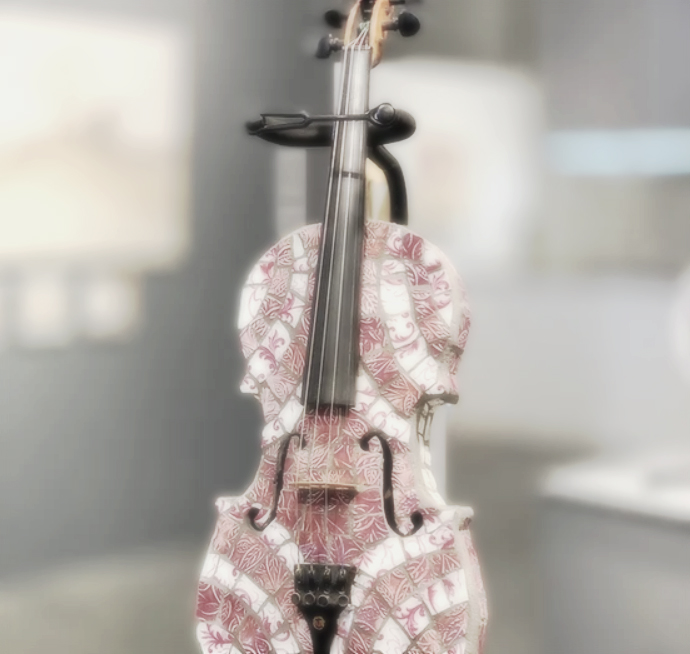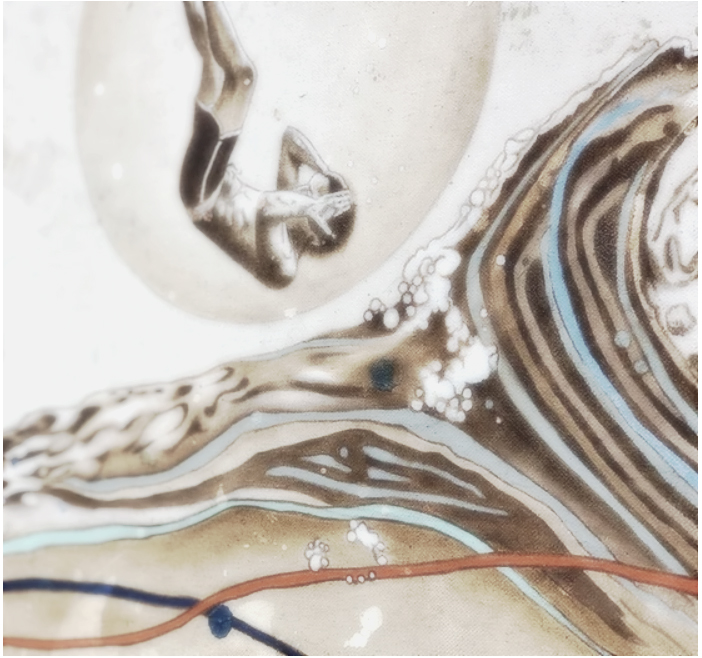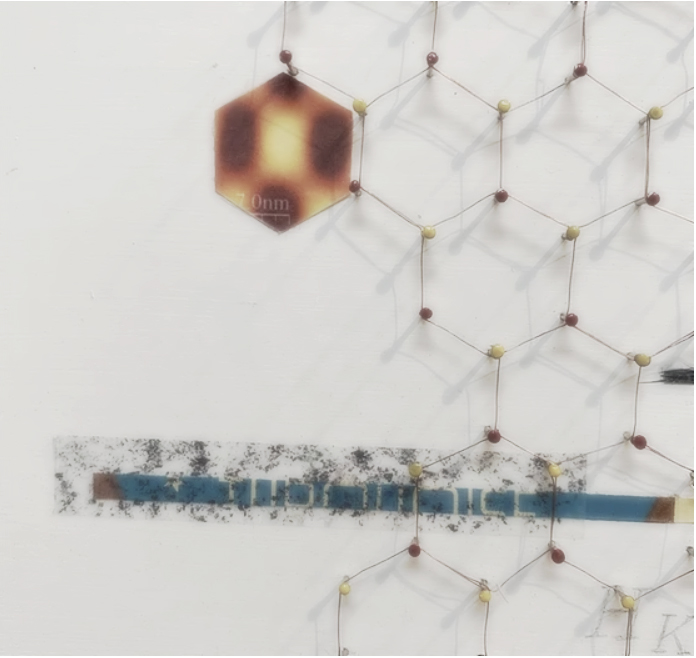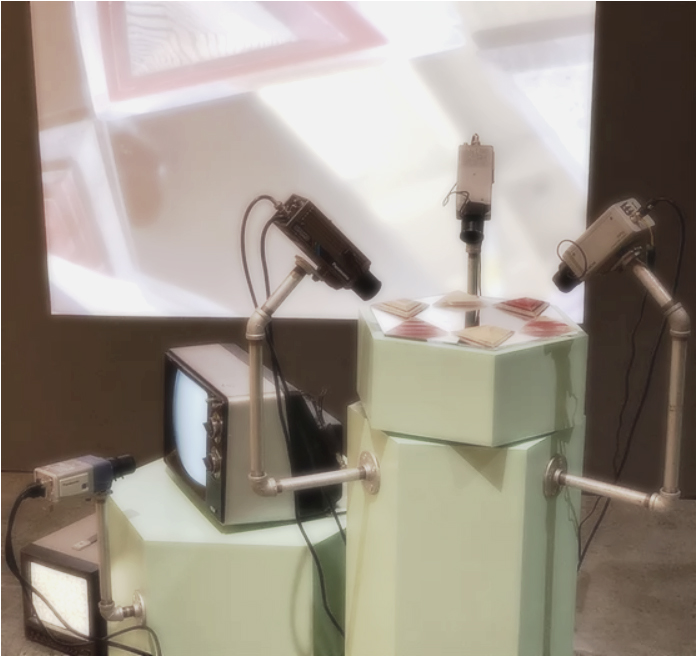
Beth Percell – artist
Here is the art part! This was an inspiring and challenging project! I understood that sound makes patterns. Many of us have had the experience of listening to music and seeing patterns and colors. Actually seeing sound resonance patterns for each instrument and figuring out how to transfer them onto the instrument was a different story. It took several attempts to actually, draw the chosen pattern on each instrument. Hmmm…. then how to choose color? I decided that each instrument needed one basic color to really show off the pattern. I turned to my musician friends, with the question … “What color do you see when you play your instrument?” Much to my surprise, they all reported back that they did not associate any color with their specific instruments! I decided that I would spend a little time listening to a variety of music involving each instrument, and try to connect a color with each one. The colors you are viewing are the colors I “saw” or felt or intuited for each instrument. I then went to task choosing my materials, based on color, design, and texture. I really enjoyed handling these beautiful instruments intimately and creating colored cloaks for each one. Keep in mind that I used a little artistic license with each of them, as they became personal pieces for me. I hope you enjoy viewing them as much as I enjoyed thinking, dreaming, envisioning, and creating them.
Stephanie Bailey Ph.D.
Every object has a characteristic frequency or resonance at which it vibrates most, with the least input of energy. Though you may not be familiar with this term, you actually took advantage of resonance at a very young age. A child’s swing has a natural frequency at which it likes to swing ß(resonance). To get the swing going, you pump your legs and arms in time with this natural frequency. The motion builds up with each swing because you are driving the swing at its resonance frequency. If you drove the swing at any other frequency, you would barely move. String instruments are no different except that they resonate at several distinct frequencies. Interestingly, these resonances are important determinants in the sound of the instruments and have unique patterns associated with them. One effective way to see these patterns is to sprinkle sand on it and attach it to a source of vibration. When the instrument vibrates at a resonant frequency, a pattern appears in the sand. To our knowledge, this is the first time a mosaic has been made of resonance patterns on actual string instruments (guitar, violin, mandolin, and banjo). In addition to beautiful works of art, these instruments can be used as a tool to teach students about musical acoustics. The front and back plates of the guitar are modeled at 656 Hz and 385 Hz, respectively. Hz is the symbol for Hertz and measures frequency. A frequency of 656 Hz means that the front guitar plate vibrates 656 times each second! The front and back plates of the violin are modeled at 116 Hz and 304 Hz, respectively.

Sarah Bianco – artist
Having an opportunity to collaborate with a scientist on an art project was in itself interesting to me. I was curious about where physics and my intuitive style of painting would overlap and hopefully inspire new work. Upon meeting Joseph Connell, “Zippy”, I immediately got excited to see what was to come from this experiment. We talked for hours, and it became clear that though our tools may be different, both of our lives were committed to attempting to understand some of the great mysteries of the Universe. Our correspondences thereafter were filled with introductions to so many fascinating scientific concepts and much of our discussions were on the nature of relationships. We eventually decided to depict wave functions and the uncertainty principle, with an underlying narrative of our personal examinations within the project itself. The paintings contain themes of the unknown, which is a common thread throughout my work. Full of contrasts, they illustrate the distinguishing characteristics of each of us while containing deeper metaphoric explorations of consciousness, union, and surrender. It was a joy connecting with Zippy. Our creative and introspective conversations were truly inspirational to each other’s lives and work.
Zippy Connell – Ph.D. Candidate
I have always wondered how I could use surfing to teach quantum mechanics, and Sarah was up for the challenge. We can imagine a surf break being described by a complicated wave function. Before checking the waves, you imagine the conditions resembling the other experiences you have had there. There is a chance that you’ll find huge waves, small waves, or none at all. In quantum mechanics, there are inherent uncertainty measurements, and when you make an observation, only specific outcomes are allowed.
We can also apply this concept to our relationships. Imagine a close friend of yours. You never know what mood they will be in before you see them, but say they are funny 75% of the time, and sad 25%, for example. They are a superposition of funny and sad, and when you see them, they will be one or the other. Sarah’s big painting is a complicated wave function, a superposition of many simple waves. The simple waves are the possible outcomes of a measurement (hence the “quanta” of quantum mechanics). The smaller paintings represent a few observations, or measurements, of the wave function. You can know how often you get a certain result on average, but not what an individual measurement will yield, so the outcomes are uncertain (Heisenberg’s uncertainty principle). Sarah also included a bubbly interpretation of our emergent deep friendship in the paintings.

Tauna Coulson – artist, curator
I met Arturo at his lab on Delaware Street where he operates the Scanning Tunneling Microscope(STM) which both images and manipulates surfaces at the atomic level. The technology was discovered in 1984 by doctors Bennig and Rohrer in Zurich, earning them the Nobel Prize in 1986. Currently, Arturo is examining graphene, a single atomic layer of graphite, discovered in 2004 by Nobel Laureates Geim and Novoselov. I knew when we first met that this was a good match. It wasn’t until he took me into the lab and shared his work did I realize we were a perfect match, I felt incredibly lucky Arturo had chosen to work with me. The STM is fantastic–it has shown us an entirely new world at a scale of 1/1000th a hair’s width. The microscope is the size of a small car, elaborate, very shiny, and yet hanging off one end is a perfectly recognizable 33mm camera and a surprising amount of aluminum foil. It was hard to wrap my head around the idea of four Kelvin(-1,830oF), the temperature of the materials studied, necessary in bringing the atoms and electrons to a near standstill. What further delighted me was that graphene was the current material being studied in this state-of-the-art STM. I grew up with graphene in my hand nearly every day, graphene was taken from graphite, my pencil. Surprisingly its highly technological breakthrough was discovered using ordinary cellophane tape, seen here. The new properties my pencil took on are nothing short of miraculous and I was getting to learn about it! Physics is now part of my life. I wonder what else is right under my nose? In my hands? I later moved into the design field, scanning those carefully drawn images into the computer. The “block” was drawn some twenty years ago for clothing tags, which I then finalized using Illustrator. Why is this relevant? Graphene is revolutionizing the computer industry–picture that magic, transparent screen, seeming to float in the air and 1000 times faster. Creating this work has been one of my most difficult challenges, the balance of graphic design and fine art. I’m infinitely happy it brought together both my disciplines. Imaging hexagons, printing them out, and transferring them using my pencil. My work alongside Arturo, completely new and exciting. I thought of his long hours as I carefully cut and placed every pin, painted every head, and wrapped copper wire, aware of his own years of careful, exacting work. It was a rich experience on many levels, from my connection with Arturo to the final outcome.
Arturo Quezada – Ph.D.
A small island of simplicity and order in the middle of a sea of chaos is a fitting description of both the work I do as an experimental physicist and the work Tauna produces as an artist. That is why I instantly chose to be paired with Tauna, and feel extremely lucky to have done it. I was particularly mesmerized by her work “Head Room” because it was so reminiscent of the STM. The physically static, yet mentally active expression of the figures amongst the chaos in the room, captured elegantly the work my colleagues and I do. The interplay of large areas intertwined with small pieces and forms in Tauna’s art is ideal to capture the sense of scale in nano-science. The STM uses the quantum mechanical phenomena known as tunneling to gently and precisely count electrons that tunnel from the sample, through a wall, and end up on a very sharp metallic tip. It is like this that creates images that show individual atoms. With this instrument, we study graphene. Graphene is an atomically thin layer of graphite. It consists solely of carbon atoms arranged in a honeycomb structure. This peculiar formation gives graphene its many exciting properties like strength, flexibility, transparency, electric tunability, and (last but not least) the fact that electrons in graphene buzz around just like light particles do! All these properties make graphene a highly promising platform that could potentially revolutionize the computer, sensor, and energy industries. Working on this triptych with Tauna has not only made me appreciate the work I do more but has also inspired me to improve as a science communicator. We often get caught up on little details about our work. (The voltage we used in the last experiment, the number of samples we have to prepare, plotting the latest data set) These technicalities make us forget to step back and take a moment to appreciate the accomplishments we have made thus far and the impact our work could have on future technologies. As Tauna and I worked on these panels, I realized that the most interesting questions I’ve been asked, more often than not, come from people outside the lab.

Ann Altstatt – artist
A Device for the Indirect Observation of Organized Matter:
Instructions for Use
This device is intended for learning the details of structures we can not directly see. Reserve your time on the device long in advance– be prepared to work through the night, if necessary. The equipment is both specialized and composed of parts you may recognize from elsewhere. Be prepared to conduct repairs as needed. Watch out for radiation exposure levels, which may increase with repeated use. Security clearance is required.
Begin with the idea that on a basic level, we don’t know what is going on and work up from there. Note the tessellated structure of the organized matter before you. Keep in mind the planes of symmetry in your sample and adjust alignment in the device as needed. Repeat. You need to know what you are looking at in order to imagine how to see it. Invisible light is absorbed into and reflected off of multiple surfaces, allowing us to view all sides at once. Notice how symmetry changes with different inputs to the system. Many small independent factors give rise to unpredictable complex behaviors. Analyze the resulting patterns. Run as many trials as you can. Your theoretical model may resemble the sample you cannot observe directly, but how will you know what details you’re missing? This device is reserved for someone else after you are done with this examination. Please don’t leave the building with the device key in your pocket.
Cameron MacKeen – Ph.D.
In physics and in life we look for reasons, and usually, we strive to break down our understanding into fundamental concepts. There is beauty in simplicity, but the world is not simple. If we know the electronic energy levels in hydrogen and oxygen, can we predict the shape of a snowflake next winter? Phenomena emerge when transitioning from a one-body problem to a many-body problem, and it is the interactions of simple systems that induce a theory: more is different. From time to time, Cam MacKeen zips over the hill to the synchrotron at SLAC in order to collect x-ray absorption data of various powdered crystals. Fine oscillations due to the self-interference of an ejected electron’s wavefunction provide him with information about the local structure. When studying crystal structure it is helpful to think of balls and sticks, but what scientists observe is far from that. Fortunately, order and symmetry emerge as a lattice of quintillions of atoms, and Cam wants to know how they are arranged and how they vibrate. To find this out, he drinks coffee, loads the sample in a decades old cryostat, exposes the sample to a brilliant x-ray beam, and stares at a squiggle crawl across the screen as the clock strikes 4 AM. Carefully analyzing this data can reveal the physical origin of anomalous behavior and phase transitions exhibited by these materials. With knowledge scientists can exploit special characteristics; one day our refrigerators won’t need a liquid refrigerant and our solar panels won’t contain silicon. Until then and thereafter, the complexity of nature demands us to
push into the unknown indefinitely.